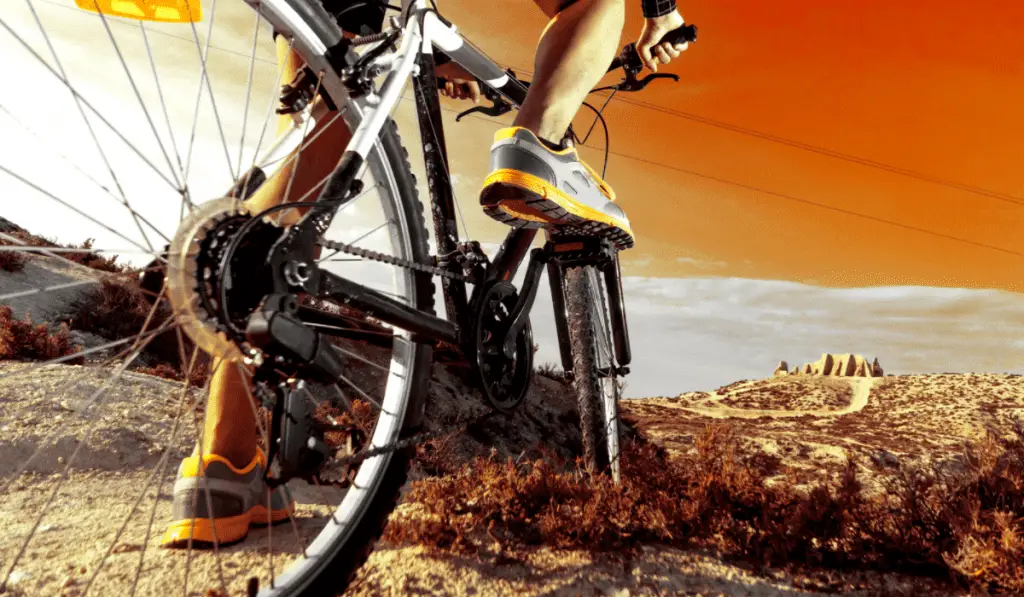When you’re traversing different landscapes, including muddy and rocky terrain, you need to have proper safety systems to protect you and your vehicle if you come across any significant roadblocks on your trail. The safety mechanism is important to control the speed of your mountain bike when you’re riding downhill, and it is also used to prevent your bike from sliding backward when you’re going uphill.
Mountain bikes incorporate the latest technology when it comes to safety as the activity can be dangerous, which is why most modern bikes incorporate hydraulic disc brakes.
If you’re a biking enthusiast and want to know everything about your bike, you might have certain questions about your brakes, including ‘how do mountain bike hydraulic disc brakes work?’
We’ll be going into detail about braking systems in general and specifically hydraulic disc brakes, so you can better understand your bike and even resolve some minor issues to keep your bike running smoothly.
Why Use Disc Brakes?
Disc brakes have overtaken the once-popular rim brakes to be used on vehicles ranging from bikes to cars and trucks. Bicycle brakes such as those used in mountain bikes work through a mechanism controlled by a lever system that can be operated by the rider from the handlebars.
The brakes are fitted with a brake pad that comes into contact with the braking surface to create friction, thereby slowing the bike.
The mechanism for both brakes varies as disc brakes primarily apply force to a rotor located at the center of the wheel’s hub while rim brakes apply the force on the wheel’s outer frame close to its edge.
Rim brakes mainly come in a mechanical format, but when it comes to disc brakes, they come in both mechanical and hydraulic depending on the choice of the biker and manufacturer.
Disc brakes are rapidly becoming the norm as they have a more effective and controlled response when the hand-controlled lever is pressed. The disc brakes are capable of generating a high amount of stopping force with minimal effort required on the part of the cyclist.
This system is also more reliable in unfavorable weather conditions such as rain. You might experience a delay with rim brakes due to its outer positioning than the disc braking mechanism, which halts the bike close to the rotor.
The disc brakes work well in all weather conditions as the braking surface is further from the ground than the rim brakes. The calipers are also better protected, and the holes in the disc better displace water which prevents any delays in braking.
These brakes also have a greater stopping power than rim brakes thanks to the calipers, which can be made very stiff, and the fact that the disc is much smaller than the rim on a bicycle wheel, which means they can brake earlier, giving more braking power during the initial application of the brake.
Braking is also more consistent with disc bikes as there is increased control or so-called better modulation, which means you can be sure of the resultant braking power you’ll get from each pull of the brake lever.
Read How many days a week should I mountain bike?
What Are The Types Of Disc Brakes?
Before we get into the reasons for using hydraulic disc brakes, we need to consider the other braking systems available.
Hydraulic Disc Brakes vs. Mechanical Brakes
It wouldn’t be a fair analysis of braking systems if we didn’t consider the alternative to hydraulic disc brakes – mechanical brakes. There are two types of disc brakes – mechanical and hydraulic.
Mechanical brakes are cable-actuated as there is a cable attached to the brake levers to activate the braking system in a similar way to rim brakes.
Hydraulic disc brakes do away with the cables and push hydraulic fluid into a fully sealed line from a reservoir. Increased pressure is applied to the caliper when you brake, which presses the pads against a disc.
A disc brake has a rotor that looks like a metal disc attached to the front and rear wheel hubs, while the calipers are attached to the frame or fork. The calipers contain pistons that sit on either side of the disc behind the brake pads.
The calipers are attached to the brake levers by the brake lines, so when you brake, pressure is applied to the pistons, which engages the pads around the disc as the pads drag against the disc and, therefore, the wheel. This mechanism slows down the bike as kinetic energy is transformed into thermal energy.
Most discs or rotors are made of high-quality stainless steel that ranges in diameter from 140 mm up to 20 mm for most road and gravel bikes.
There are holes in the disc so that water and other debris can get out from under the brake pad to ensure there is no obstruction during braking.
Read How to Know My Mountain Bike Size
How Do Hydraulic Disc Brakes Work In Mountain Bikes?
Modern mountain bikes come with hydraulic brakes, which means they use a specially designed fluid to convert the force that you exert on your lever on the handlebar into braking power down at the rotor located at the wheel.
The parts of all the brakes include the handlebar, which has an entire unit known as the lever assembly, which consists of the lever blade, which is easy to bend as it requires minimal force.
Once you pull the lever blade attached to the lever body, the piston inside the system pushes fluid from the reservoir through the hydraulic hose down to the caliper.
Inside your caliper, you have your brake pads which are located in front of the pistons that push the pads against your rotor.
Once the lever is released, the fluid returns to the reservoir, and the pressure on the brake pads are eliminated, which allows you to ride normally.
Read How to Climb Faster on a Mountain Bike?
What Are The Inner Workings Of A Hydraulic System In Mountain Bikes?
To understand how these components work together, you’ll need to know some basic physics so you can understand the hydraulic system. Every state of matter is made of atoms and molecules.
The molecules in fluids are close together, and as such, they are incompressible; however, when heat is applied to any liquid, the molecules gain kinetic energy and start to move faster, which creates greater intermolecular spaces, converting them into gaseous form and making them easier to compress.
When your brakes are set up properly, the only thing inside the system is an incompressible fluid. When you push the level located close to the handlebar, the piston forces the fluid through the hose down to the caliper and forces the pistons out to squeeze on your rotor.
This lever is designed to give your finger a mechanical advantage, and it essentially multiplies the power that your finger could normally apply to a set of pads and rotors to make them stop faster.
However, if air gets in the system, there is space available for compression, which reduces the force that is exerted on the piston.
If you squeeze the lever with gas in the system, the piston will push on the little air bubble, squeeze it into smaller air bubbles, and your brakes won’t function properly as the pistons won’t push as hard against the rotor.
This is also why we use a special fluid as brakes typically generate a lot of heat due to the friction, and if our fluid turned into a gas when we needed it most, that piston would then be pressing on those gaseous bubbles of the fluid instead of doing anything to help us slow down.
Read How to Clean An Electric Mountain Bike?
How To Maintain Your Hydraulic Disk Brakes
Read How to Climb Rocks on a Mountain Bike
Watch Out For Air Bubbles
Hydraulic brakes function efficiently if they are fitted properly, and there are no issues in the system. As the system involves a closed loop, as long as there’s no damage or air entering the braking mechanism, you’re good to go.
However, air does make its way inside the braking system from time to time. If you feel your bike has a spongy or loose brake lever that needs to be pulled a great distance before the brake pads begin working, it is often the first sign of air in your hydraulic system, and that’s when it’s time to bleed your brakes.
Bleeding in braking terms is a process that involves replacing the hydraulic fluid in the system to remove any air trapped. It is also important to ensure the right hydraulic fluid is used to ensure it can remain a liquid when your bike generates heat during cycling.
The procedure for replacing the fluid varies between different brake manufacturers to some degree, but it essentially entails pushing new fluids through the system so that air bubbles are flushed out.
The bleeding process can be done by professional mechanics, or if this is a project that you wish to undertake on your own, there are resources available for most manufacturers on how you can perform the task yourself with the right tools.
There is no set time limit after which you should get your brake fluid replaced, but it’s good practice to get them checked at least twice a year, depending on how frequently you use your mountain bike.
You need to maintain regular checks to ensure your brakes are working properly, as they are the main line of defense from any cycling injuries.
Read Best mountain biking backpacks in the market now
Listen For Strange Sounds
Disc brake noise may be produced by a variety of factors under standard riding conditions, but it’s typically an indicator of worn pads, a skewed caliper, or a damaged rotor.
Remove the wheel and examine the pads and calipers visually. It’s a good idea to extract the pad materials for a closer look if they appear to have gone down and are getting close to the rear plate.
If you find that the pads are worn out and that a new set is required, you need to do more than simply replace the pads. The pistons in the calipers lengthen as the pads wear down to fit the thinner pads. The piston must be reset and pushed back into the caliper before installing the new pad.

After you’ve reset the pistons and installed the new pads, you’ll want to double-check that everything is still snug and secure. Start by tightening the rotor nuts before placing the wheel back on the body.
The most basic thing you can do to ensure a safe ride when you get on your bike is to keep your brakes in good working order. When dealing with disc brakes, it’s critical to keep everything clean and clear of any damages and contaminants, as they can negatively affect braking effectiveness.
Always check your bike and brakes before you venture off on a mountain biking adventure, and don’t skip on regular maintenance to keep it running smoothly through a range of terrains.
Related mountain bike articles:
- Best Electric Mountain Bike with Removable Battery
- How Much Does a Mountain Bike Weigh?
- How to Install A Rear Derailleur on A Mountain Bike?
- Hardtail mountain bikes you should buy
- 6 Best Electric Mountain Bikes Under $4000

I am Michael, an avid rider and bike expert. I am here to provide, biking tips and expert advice on in-depth bike reviews covering features, capabilities, price range, and much more. Specially on electric bikes, mountain bikes, road bikes, etc. I will provide honest product reviews, along with expert advice on purchasing, training, and maintenance. Check out my complete profile.





